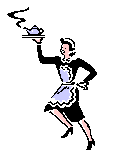
 |
Tea Clipper |
 |
| from TeaAntiques.com | ||
| Edition Ninety Nine |

 An
exquisite and rather rare Chamberlain's Worcester jug, c1810. This jug is one of
the larger sized jugs at 5¼" (135mm) in height and is beautifully decorated
with finely and richly gilded floral decoration with a dot and ellipse border. This
pattern is illustrated on a coffee pot Plate 66 in 'Chamberlain Worcester Porcelain
1788-1852', by Geoffrey A. Godden and given as pattern number 120. This pattern
is described in Chamberlain's pattern book as 'white and gold star border, old tyer'.
An
exquisite and rather rare Chamberlain's Worcester jug, c1810. This jug is one of
the larger sized jugs at 5¼" (135mm) in height and is beautifully decorated
with finely and richly gilded floral decoration with a dot and ellipse border. This
pattern is illustrated on a coffee pot Plate 66 in 'Chamberlain Worcester Porcelain
1788-1852', by Geoffrey A. Godden and given as pattern number 120. This pattern
is described in Chamberlain's pattern book as 'white and gold star border, old tyer'.
The rich honey coloured and fine gilding is applied to the body of the jug, handle and pouring lip. Below the gilt border on the body of the jug are three evenly spaced gilt floral bouquets, each very finely executed.



The jug stands upon a raised circular foot rim, the base ring of which is unglazed. In the centre of the underside of the jug is the manufacturer's mark 'Chamberlains Worcester' in red oxide script. This is certainly a magnificent jug for the collector of Chamberlain's Worcester or early English porcelain.
More details of this item and other tea related antiques can be found by visiting my web site at www.TeaAntiques.com.
 Hever
Castle is a popular place for tourists from around the world. It is always busy
and bustling with families as Hever is not just the Castle, but almost a 'theme
park' where there is lots to occupy visitors of all ages. The Castle forms just
a part of what is on offer, which includes the Gardens, Yew and water maze, adventure
playground & tower maze, boating lake and live events hosted throughout the
season.
Hever
Castle is a popular place for tourists from around the world. It is always busy
and bustling with families as Hever is not just the Castle, but almost a 'theme
park' where there is lots to occupy visitors of all ages. The Castle forms just
a part of what is on offer, which includes the Gardens, Yew and water maze, adventure
playground & tower maze, boating lake and live events hosted throughout the
season.
The Castle itself dates back to the 13th century and is famously known for being the childhood home of Anne Boleyn, second and ill-fated wife to King Henry VIII and mother to Queen Elizabeth I.
Astonishingly, Hever Castle in its over 700 year history has been mainly in the ownership of only six families. It all started with the Norman family of de Hever. They built a farmhouse here and fortified it with a keep and a protective wall to protect their live stock. The whole was further protected by a surrounding moat.

 Large
alterations to the place were made in 1450-1550 by the Bullens made it into a more
spacious manor house within the confines of the protective walls. The next
two families to own Hever were the Waldegraves and Hurnfreys who took it up to 1750.
Large
alterations to the place were made in 1450-1550 by the Bullens made it into a more
spacious manor house within the confines of the protective walls. The next
two families to own Hever were the Waldegraves and Hurnfreys who took it up to 1750.
Between 1750 and 1903 it was in the hands of the Meade Waldos. They however resided at Stonewall Park, which was their other house just 2 miles away. Thus they let the Castle out to various tenants. During this period many of the larger rooms were divided up, windows blocked up to avoid window tax and generally the Castle became rather shoddy. This was put to rights by a tenant in 1895, Captain Guy Sebright. He and his wife were responsible for a lot of the Castle's restoration work and for laying out the gardens around the moat.
In 1903, the Castle passed from Edmund Meade Waldo to William Waldorf Astor. He was a very wealthy man and one of experience in building construction, interior design and garden layout, having had large properties in New York, Rome, London and Cliveden. There was no expense spared at Hever in its recreation. His work at Hever began with a full restoration programme of the Castle and the building of a 'Tudor' style village just behind it, this providing much needed space for domestic staff and guests. His work included the formation of the large pleasure grounds and extensive formal Italian gardens, which are rather out of place against the small mediaeval Castle.

 The
Castle nestles at the bottom of a hill and despite the high number of tourists still
possesses an air of serenity and calm. The view as you approach is of the South
and West side of the Castle, with the tall fortified gatehouse at one end. The road
leading up to the Castle has along it an array of neatly trimmed topiary yew trees,
some clipped with cleverly shaped birds on top birds.
The
Castle nestles at the bottom of a hill and despite the high number of tourists still
possesses an air of serenity and calm. The view as you approach is of the South
and West side of the Castle, with the tall fortified gatehouse at one end. The road
leading up to the Castle has along it an array of neatly trimmed topiary yew trees,
some clipped with cleverly shaped birds on top birds.
Entry into the Castle is via a drawbridge over the still waters of the moat. Passing thought the stone archway with its raised portcullis, you pass under the gatehouse and out into a tiny cobbled courtyard. From here the architecture changes from the fortified stone Castle to domestic Tudor timber framed buildings with leaded light windows, some of which are bays. There are also pointed gables to them rather than Castle crenulations or battlements.



 On
the opposite side of the courtyard is the door leading into the Entrance Hall of
the Castle. From here there is a route that takes the visitor around the Castle
rooms, including the Drawing room, Inner Hall, Dining Room, Library and Morning
Room on the ground floor. Further rooms are on view on subsequent floors, including
Anne Boleyn's small wood panelled bedroom.
On
the opposite side of the courtyard is the door leading into the Entrance Hall of
the Castle. From here there is a route that takes the visitor around the Castle
rooms, including the Drawing room, Inner Hall, Dining Room, Library and Morning
Room on the ground floor. Further rooms are on view on subsequent floors, including
Anne Boleyn's small wood panelled bedroom.
The Castle contains some beautiful contemporary furniture, paintings, armour as well as items associated with Anne Boleyn. In the Morning Room are two later items of tea equipage, a Pratt ware tea canister with moulded macaroni figures c1790 and a late eighteenth century Hew Hall tea set.

 On
the second floor it is worth looking out of the windows to the gardens as it affords
some good views over the Yew maze and a fabulous and most unusual topiary chess
set in golden Yew. The pieces are based on a chess set from the Henry VIII period.
In front of the chess set is an armillary sphere that dates from c1710. It was used
to calculate the altitude of the sun, moon and stars from which you could calculate
time and latitude.
On
the second floor it is worth looking out of the windows to the gardens as it affords
some good views over the Yew maze and a fabulous and most unusual topiary chess
set in golden Yew. The pieces are based on a chess set from the Henry VIII period.
In front of the chess set is an armillary sphere that dates from c1710. It was used
to calculate the altitude of the sun, moon and stars from which you could calculate
time and latitude.



Although rather out of character with the Castle, the formal Italian garden is spectacular, with classical sculptures and columned structures. Along one side is a long Pergola of stone and on one side all along a sectioned rock and stone water cascade. the little pools have green ferns and vegetation growing growing around them and water also spurts forth from a variety of carved stone heads.




 There
is a pretty rose garden, restaurant and woodland walks to enjoy. For the children
there is also the water maze, where if you take a wrong turn you are likely to get
very wet from spouts of water which suddenly appear!
There
is a pretty rose garden, restaurant and woodland walks to enjoy. For the children
there is also the water maze, where if you take a wrong turn you are likely to get
very wet from spouts of water which suddenly appear!
The nearby river to the Castle was diverted to create the extensive lake at the end of the Italian garden and there is a long walk which takes you right round the lake passing over bridges and rock cascades.
A place to take the whole family - what ever age, Hever now has more than its history to give.
Hever castleTo review past newsletters, just follow this link:
Past newsletters.
To subscribe to this free newsletter -
Click here